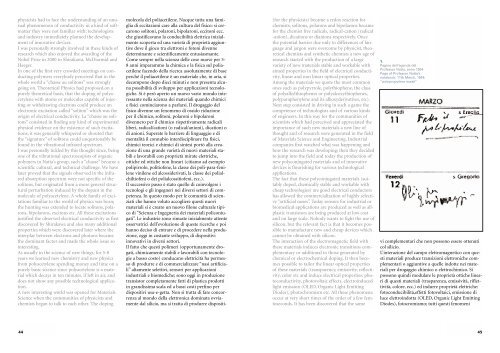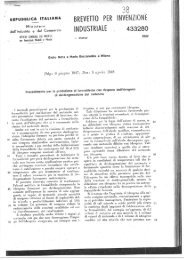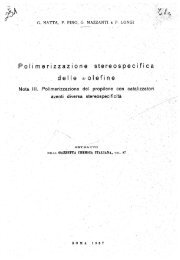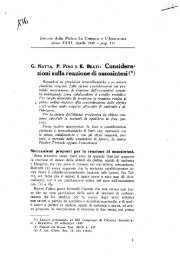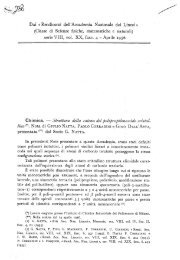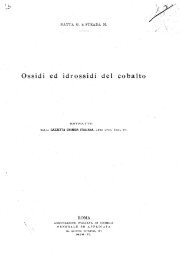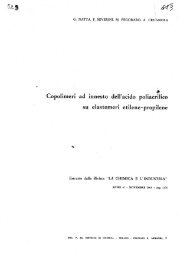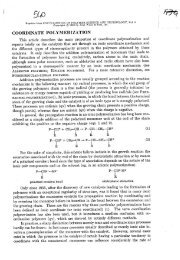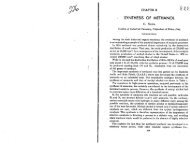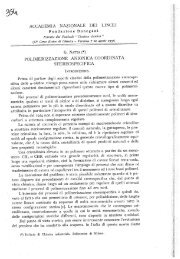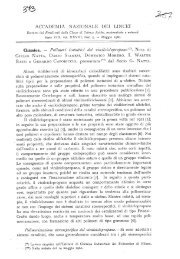n. 7, Ottobre 2003 - Giulio Natta
n. 7, Ottobre 2003 - Giulio Natta
n. 7, Ottobre 2003 - Giulio Natta
You also want an ePaper? Increase the reach of your titles
YUMPU automatically turns print PDFs into web optimized ePapers that Google loves.
physicists had to face the understanding of an unusual<br />
phenomenon of conductivity in a kind of softmatter<br />
they were not familiar with; technologists<br />
and industry immediately planned the development<br />
of innovative devices.<br />
I was personally strongly involved in these kinds of<br />
research which also enjoyed the awarding of the<br />
Nobel Prize in 2000 to Shirakawa, McDiarmid and<br />
Heeger.<br />
In one of the first very crowded meetings on conducting<br />
polymers everybody perceived that in the<br />
whole world a “chasse au solitons” was strongly<br />
going on. Theoretical Physics had proposed,on a<br />
purely theoretical basis, that the doping of polyacetylene<br />
with atoms or molecules capable of injecting<br />
or withdrawing electrons could produce an<br />
electronic excitation called “soliton” which was the<br />
origin of electrical conductivity. La “chasse au solitons”<br />
consisted in finding any kind of experimental<br />
physical evidence on the existence of such excitations;<br />
it was generally whispered or shouted that<br />
the “signature” of solitons could unqustionably be<br />
found in the vibrational infrared spectrum.<br />
I was personally tickled by this thought since, being<br />
one of the vibrational spectroscopists of organic<br />
polymers in <strong>Natta</strong>’s group, such a “chasse” became a<br />
scientific cultural, and technical challenge. We have<br />
later proved that the signals observed in the infrared<br />
absorption spectrum were not specific of the<br />
solitons, but originated from a more general structural<br />
perturbation induced by the dopant in the<br />
molecule of polyacetylene. A whole family of excitations<br />
familiar to the world of physics was born;<br />
the hunting was extended to locate solitons, polarons,<br />
bipolarons, excitons etc. All these excitations<br />
justified the observed electrical conductivity as first<br />
discovered by Shirakawa and also many additional<br />
properties which were discovered later where the<br />
interplay between electrons and photons became<br />
the dominant factor and made the whole issue so<br />
interesting.<br />
As usually in the science of new things, for 5-8<br />
years we learned new chemistry and new physics<br />
from polyacetylene spending money and time on a<br />
purely basic science since polyacetylene is a material<br />
which decays in ten minutes, if left in air, and<br />
does not show any possible technological application.<br />
A new interesting world was opened for Materials<br />
Science when the communities of physicists and<br />
chemists began to talk to each other. The doping<br />
molecola del poliacetilene. Nacque tutta una famiglia<br />
di eccitazioni care alla cultura del fisico: si cercarono<br />
solitoni, polaroni, bipolaroni, eccitoni ecc.<br />
che giustificavano la conducibilità elettrica inizialmente<br />
scoperta ed una varietà di proprietà aggiuntive<br />
dove il gioco tra elettroni e fotoni divenne<br />
determinante e scientificamente entusiasmante.<br />
Come sempre nella scienza delle cose nuove per 5-<br />
8 anni imparammo la chimica e la fisica sul poliacetilene<br />
facendo della ricerca assolutamente di base<br />
perché il poliacetilene è un materiale che, in aria, si<br />
decompone dopo dieci minuti e non presenta alcuna<br />
possibilità di sviluppo per applicazioni tecnologiche.<br />
Si è però aperto un nuovo vasto mondo interessante<br />
nella scienza dei materiali quando chimici<br />
e fisici cominciarono a parlarsi. Il drogaggio del<br />
fisico divenne un fenomeno di ossido riduzione<br />
per il chimico, solitoni, polaroni e bipolaroni<br />
divennero per il chimico rispettivamente radicali<br />
liberi, radical/cationi (o radical/anioni), dicationi o<br />
di anioni. Superate le barriere di linguaggio e di<br />
mentalità il connubio interdisciplinare fra fisici,<br />
chimici teorici e chimici di sintesi portò alla creazione<br />
di una grande varietà di nuovi materiali stabili<br />
e lavorabili con proprietà mirate elettriche,<br />
ottiche ed ottiche non lineari (citiamo ad esempio<br />
polipirrolo, politiofene, la classe dei poli-para-fenilene<br />
vinilene ed alcossiderivati, la classe dei polialchiltiofeni<br />
o dei polialcossitiofeni, ecc.).<br />
Il successivo passo è stato quello di coinvolgere i<br />
tecnologi e gli ingegneri nei diversi settori di competenza.<br />
In questo modo per le comunità di scienziati<br />
che hanno voluto accogliere questi nuovi<br />
materiali si è creato un nuovo filone culturale tipico<br />
di “Scienza e Ingegneria dei materiali policoniugati”.<br />
Le industrie sono rimaste inizialmente attente<br />
osservatrici dell’evoluzione di queste ricerche e poi<br />
hanno deciso di entrare e di procedere nella produzione,<br />
oggi in costante sviluppo, di dispositivi<br />
innovativi in diversi settori.<br />
Il fatto che questi polimeri (opportunamente drogati,<br />
chimicamente stabili e lavorabili con tecnologie<br />
a basso costo) conducano elettricità ha permesso<br />
di produrre e di commercializzare “nasi artificiali”<br />
altamente selettivi, sensori per applicazioni<br />
industriali e biomediche; sono oggi in produzione<br />
transistor completamente fatti di plastica prodotti<br />
in grandissima scala ed a bassi costi perfino per<br />
dispositivi usa-e-getta. Non si tratta di fare concorrenza<br />
al mondo della elettronica dominata ovviamente<br />
dal silicio, ma si tratta di produrre dispositi-<br />
(for the physicists) became a redox reaction for<br />
chemists; solitons, polarons and bipolarons became<br />
for the chemist free radicals, radical-cation (radical<br />
-anion), dications or dianions respectively. Once<br />
the potential barrier due only to differences of language<br />
and jargon were overcome by physicist, theoretical<br />
chemists and synthetic chemists a new age of<br />
research started with the production of a large<br />
variety of new materials stable and workable with<br />
aimed properties in the field of electrical conductivity,<br />
linear and non linear optical properties.<br />
Among the materials we quote the most common<br />
ones such as polypyrrole, polythiophene, the class<br />
of polyalkylthiophenes or polyalcoxythiophenes,<br />
polyparaphenylene and its alkoxyderivatives, etc).<br />
Next step consisted in driving in such a game the<br />
competence of technologists and of various kinds<br />
of engineers. In this way for the communities of<br />
scientists which had perceived and appreciated the<br />
importance of such new materials a new line of<br />
thought and of research were generated in the field<br />
of Materials Science and Engineering. Industrial<br />
companies first watched what was happening and<br />
how the research was developing; then they decided<br />
to jump into the field and today the production of<br />
new polyconjugated materials and of innovative<br />
devices is flourishing for various technological<br />
applications.<br />
The fact that these polyconjugated materials (suitably<br />
doped, chemically stable and workable with<br />
cheap technologies) are good electrical conductors<br />
has allowed the commercialization of highly selective<br />
“artificial noses”. Today sensors for industrial or<br />
biomedical applications are produced as well as allplastic<br />
transistors are being produced at low cost<br />
and on large scale. Nobody wants to fight the use of<br />
silicon, but the relevant fact is that it becomes possible<br />
to manufacture new and cheap devices which<br />
cannot be obtained with silicon.<br />
The interaction of the electromagnetic field with<br />
these materials induces electronic transitions complementary<br />
or additional to those generated by<br />
chemical or electrochemical doping. It then becomes<br />
possible to tailor the linear optical properties<br />
of these materials (transparency, emissivity, reflectivity,<br />
color etc and induce electrical properties: photoconductivity,<br />
photovoltaic effects, electroinduced<br />
light emission (OLED, Organic Light Emitting<br />
Diodes), photochromism etc. All these phenomena<br />
occur at very short times of the order of a few femtoseconds.<br />
It has been discovered that the same<br />
1.<br />
Pagina dell’agenda del<br />
Professor <strong>Natta</strong>, anno 1954<br />
Page of Professor <strong>Natta</strong>’s<br />
notebook: 11th March, 1954:<br />
“polypropylene made”<br />
vi complementari che non possono essere ottenuti<br />
col silicio.<br />
L’interazione del campo elettromagnetico con questi<br />
materiali produce transizioni elettroniche complementari<br />
o aggiuntive a quelle indotte nei materiali<br />
per drogaggio chimico o elettrochimico. Si<br />
possono quindi modulare le proprietà ottiche lineari<br />
di questi materiali (trasparenza, emissività, riflettività,<br />
colore, ecc.) ed indurre proprietà elettriche:<br />
fotoconducibilità,effetti fotovoltaici, emissione di<br />
luce elettroindotta (OLED, Organic Light Emitting<br />
Diodes), fotocromismo; tutti questi fenomeni<br />
44<br />
45


